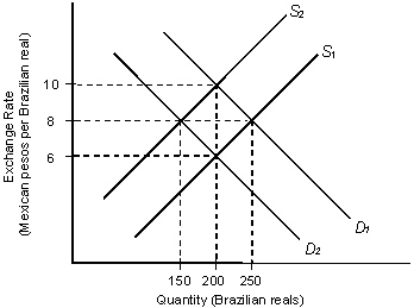The figure given below depicts the demand and supply of Brazilian reals in the foreign exchange market.Assume that the market operates under a flexible exchange rate regime. Figure 36.1  In the figure:
In the figure:
D1 and D2: Demand for Brazilian reals
S1 and S2: Supply of Brazilian reals
Refer to Figure 36.1.Determine the equilibrium exchange rate and equilibrium quantity of Brazilian reals, if D1 and S1 are the relevant demand and supply curves for Brazilian reals in this market.
Definitions:
Exponential Distribution
A probability distribution that describes the time between events in a Poisson process, showing how a process is spread out over time.
Poisson Distribution
is a statistical distribution that expresses the probability of a given number of events occurring in a fixed interval of time or space.
Dental Clinic
A healthcare facility specializing in the diagnosis, prevention, and treatment of diseases and conditions of the oral cavity.
Poisson Distribution
A probability distribution that indicates the likelihood of a specific number of occurrences happening within a certain time or space period, given that these occurrences happen at a constant average rate and are independent of the time elapsed since the prior occurrence.
Q3: In effect, during the period immediately following
Q19: Which of the following counties are largely
Q34: When the domestic currency depreciates, domestic goods
Q52: Productive efficiency is achieved when firms produce
Q90: Other things equal, the higher the deviations
Q106: Identify whether each of the following transactions
Q115: For people who are too well off
Q307: The prevalence of Alzheimer's dementia is very
Q309: Economists assume that rational behavior is useful
Q359: Refer to Scenario 1-1.Had the firm not